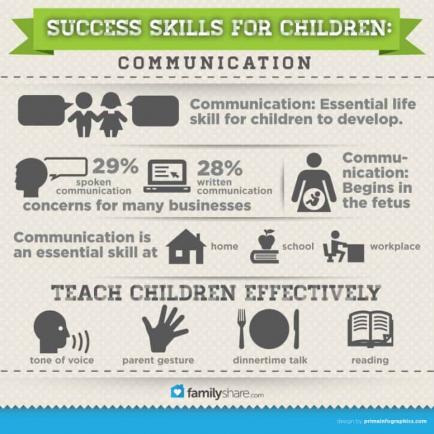
Ellen Galinsky, in her book, "Mind in the Making," describes Communication as an essential life skill for children to develop. In a study administered by her, Galinsky asked businesses about the most common skill where new hires fall below expectation. The top two concerns listed by the majority of businesses were spoken communication skills (29 percent) and written communication skills (28 percent). Children are falling behind in their ability to communicate, both effectively and professionally. Communicating is an essential skill at home, school and in the workplace. There are very few avenues of life that don't require strong communication. Children who don't learn to communicate will find personal relationships difficult, as well.
Let's consider for a moment, "when do babies start learning to communicate?"� Galinsky explains that babies begin to hear and remember sounds while still in the fetus. In tests performed, she saw that babies preferred the voice of their mothers compared to other persons. Young babies begin to mimic the sounds of their caregiver before they are able to speak. Babies respond favorably to tones of voice, as well. When a parent gets upset this emotional moment may cause the baby to cry. Galinsky points out that this is a key to helping young children to develop good communication because it helps children to regulate their emotions. If children begin to see their parent's communication as volatile and erratic, it may affect their emotional development as well as communication. Here are some suggestions formed from "Mind in the Making," that can help you teach your child to communicate effectively.
Tone of voice
Tone of voice communicates more than the words we say. They suggest whether we are happy, angry or sad. By using a tone of voice that is positive and happy, children pick up on your emotions and also learn to communicate with positive emotions. "How" you say it means more than "what" you say.
Parent gesture
Children begin to speak with their hands before their mouths. Through a study reviewed by Galinsky, she found that children who used hand gestures had a larger vocabulary when they were older. Parents can help children to communicate non-verbally by pointing, snapping, or other non-verbal gestures to explain things. This can create fun opportunities for parents and children to communicate. More importantly, children will learn to associate non-verbal behavior with emotions and implicit messages.
Dinnertime talk
(tell stories, avoid soliloquies, ask questions) - Dinnertime is a great atmosphere for children to develop communication skills. However, some dinner tables have little in-depth communication occurring. Parents can encourage good communication at dinnertime by asking questions about a child's favorite topic or tell stories. Give children the opportunities to take turns speaking.
Reading
Reading is the foundation for learning to be a great communicator. Parents can and should use various forms of communication while reading. Parents can point to pictures, ask questions about the stories and emotions of the characters. Parents can help children see other people's perspectives through the characters of the book. Children will learn to anticipate what is going to happen and can imagine different stories more readily by having read stories. This is a great time for parents and children to bond and talk about life questions. Remember, it is not the quantity of books that is important, but the quality of the time spent together. If you are able to have a conversation about a character in the story or about a question your child has the time is well spent.

